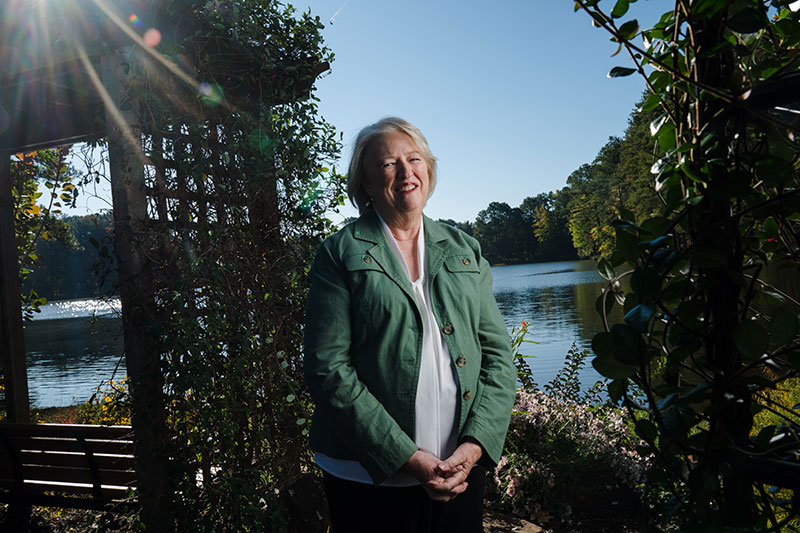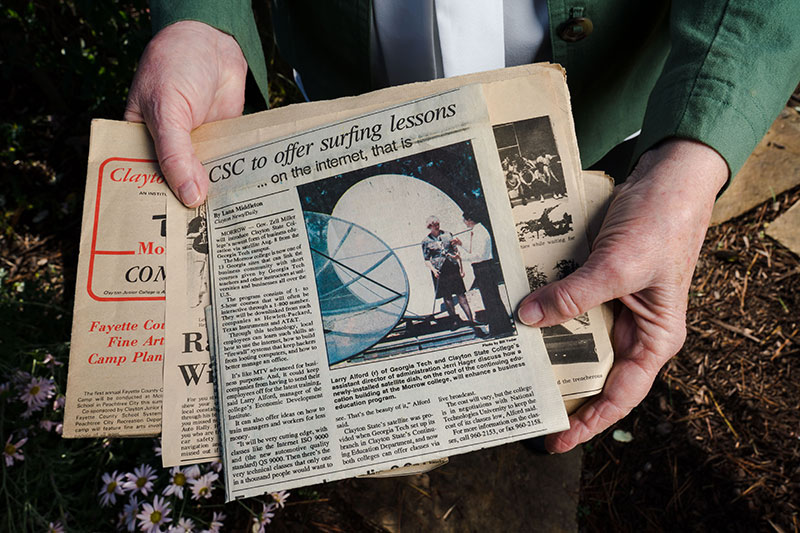On the Move
By Allison Salerno
At 22, Clayton Carte already is making a name for himself in local politics.

Share the Story on FacebookShare the Story on TwitterShare the Story via EmailShare the Story on LinkedIn
Winter 2020 | By Ruth E. Thaler-Carter
Clayton State University has been a welcoming and inclusive community since it opened its doors to its first class in 1969, and few people are more qualified to attest to that than Jerri Hager.
She was a member of the first cohort earning associate degrees when Clayton State University began as a community college. After 33 years working for the institution and eventually earning her bachelor’s, Hager holds dear to them memorable moments she has of her alma mater.
“Clayton State was personal from the beginning,” Hager recalled. “I graduated from high school at 17 and knew I ‘should’ go to college but didn’t feel ready to leave home. At the time, everyone in town was talking about the new college—everywhere you went—so I looked into it.”

As an example of the founding value of welcoming students, as well as the community at large, Hager met and had what she recalls a pleasant, informal conversation with the school’s first president, Harry Downs, when she went to pick up her application paperwork. That isn’t something that happens on most college campuses.
“I felt embraced,” Hager said. “It felt right to stay home but do something new. Everyone made me feel very comfortable at Clayton State.”
In those early days, Clayton State had fewer than 1,000 students, many of whom were taking classes while holding down jobs.
The average class size was about 20 to 25 students, and, as Hager remembered, “the first graduating class had only three students!”
“You knew everybody,” she said. “I saw a lot of folks from high school. It was also a beautiful, serene setting, with only a few buildings and faculty who was very visible—you’d see them walking around on campus. There was a friendly and safe feeling.”
The community college approach contributed to the friendly, personal atmosphere: “It was the first time I went to school with nontraditional students.”
Hager earned her associate degree and started working on campus as a student assistant.
She moved up to a full-time position in 1971 as a mailroom clerk and then as an accounts payable clerk in the business office, followed by positions in public relations and the social sciences before being named conference coordinator in continuing education and, ultimately, director of career and professional training. That was her sweet spot.
“In continuing ed, I felt I had found my spot,” Hager said. “We were training people for jobs or for something fun to do.” She found it fulfilling to be involved with students from a variety of backgrounds and interests and provide them with ways to make those interests part of their work lives.
Hager remembers feeling good about the school going in different directions from its identity in her student days and its institutional youth.
“We were going from the community college to the four-year model. The continuing education sector changed and expanded its mission as the school did the same. We saw an increased number of students because you could stay at Clayton State for all four years.”
Even the evening, continuing ed programming increased in response to the greater scope of the school, she said.
During that time, Hager took advantage of the school’s growth and expanded resources and programs to go back and earn a Bachelor of Science in Integrative Studies.
“That was a brand-new program at the time, and it was perfect for me,” she said. “You put together your own degree; I took business classes. It was ideal for students who had found jobs they loved that didn’t match their degrees.”
Such programs made it possible to use academic resources to craft a degree that fit a job better than an original degree undertaken before experiencing the work world.
As Clayton State grew and evolved into a four- year institution, Hager’s status as both student and employee gave her a front-row view of its changing nature and structure. She liked what she saw, especially “another side of the faculty that was very warm.”
Being an employee gave Hager somewhat of an insider’s perspective that a typical student wouldn’t have. “I probably saw more of the changes as an employee than as a student,” she said. “I felt very included. We all did—faculty, staff, students, community members, business leaders and more—and still do. All along the way, we were included and asked for our input.
The process always felt open. We felt like part of the plan, and it had been carried out beautifully.”
After 33 years at the school, Hager moved to the Coastal Georgia Historical Society as director of development, marketing and PR, largely thanks to the wealth of experience she enjoyed at Clayton State. When her husband’s job took their family to Manhattan, Kansas, she worked at the Flint Hills Discover Center as a development officer for the city.
She and her family are now back near Clayton State, and she is enjoying seeing the school’s continued growth.
The only cloud Hager sees on the horizon is something shared by all higher education institutions.

“The challenge, not just for Clayton State, but for all schools, communities and businesses, is to help students get a handle on college debt and make the debt worth it,” she said. “We need a focus on education that helps employees advance in the workplace.”
To this pioneer alumna and former employee, Clayton State’s future looks brighter than ever, “based on our past and what the school has accomplished so far, with faculty involved in planning and collaborating with other institutions, the local community and beyond.”
And with regard to that chance meeting with Clayton State’s first president 50 years ago, Hager says, “I guess I’m still trying to make Dr. Downs proud of me.”
It doesn’t look as if that would be a problem.
By Kelly Petty
On the fifth floor of downtown’s hipster hangout, Ponce City Market, is Mailchimp, a leading email marketing platform known as much for its services as its mammalian mascot.
By Allison Salerno
At 22, Clayton Carte already is making a name for himself in local politics.
By Kelly Petty
When a committee of faculty and staff came together in 1994 to create a time capsule containing historical items from the school’s 25 years since its inception . . .
By Adina Solomon
When you move you consume oxygen. When you move fast, your heart rate and blood pressure rises. A metabolic cart can help improve the cardiovascular system of heart patients and athletes alike.